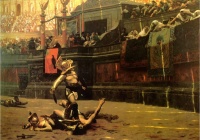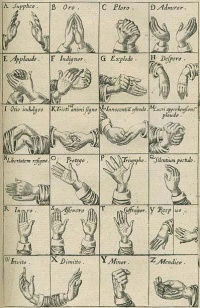Gesture
From The Art and Popular Culture Encyclopedia
(Difference between revisions)
| Revision as of 18:55, 27 April 2008 Jahsonic (Talk | contribs) ← Previous diff |
Current revision Jahsonic (Talk | contribs) |
||
| Line 1: | Line 1: | ||
| + | [[Image:John Bulwer's alphabetic chirogram from Chirologia.jpg|thumb|right|200px|[[Chirogram from John Bulwer's Chirologia|Chirogram from John Bulwer's ''Chirologia'']]]] | ||
| + | [[Image:Jean-Leon Gerome Pollice Verso.jpg|thumb|left|200px|''[[Pollice Verso (Gérôme)|Pollice Verso]]'' (1872) by Jean-Léon Gérôme]] | ||
| {{Template}} | {{Template}} | ||
| - | Gestures are a form of [[body language]] or [[non-verbal communication]]. | + | A '''gesture''' is a form of [[non-verbal communication]] made with a part of the body, used instead of or in combination with ''verbal communication''. The language of gesture allows individuals to express a variety of feelings and thoughts, from contempt and hostility to approval and affection. Most people use gestures and [[body language]] in addition to [[word]]s when they speak. The use of gesture as language by some ethnic groups is more common than in others, and the amount of such gesturing that is considered culturally acceptable varies from one location to the next. |
| - | Although some [[gesture]]s, such as the ubiquitous act of [[Hand gesture|pointing]], differ little from one place to another, most gestures do not have invariable or universal meanings, having specific connotations only in certain cultures. Different types of gestures are distinguished. The most famous type of gestures are the so-called emblems or quotable gestures (see the examples below). These are [[culture]] specific gestures that can be used as replacement for words. Communities have repertoires of such gestures. A single emblematic gesture can have very different significance in different cultural contexts, ranging from complimentary to highly offensive. | + | ==See also== |
| - | + | * [[Chironomia]] | |
| - | Another type of gestures are the ones we use when we speak. These gestures are closely coordinated with speech. The meaningful part of the gesture is temporally synchronized with the co-expressive words. For example, a gesture that depicts the act of throwing will be synchronous with the word 'threw' in the utterance "and then he threw the ball right into the window." Other gestures like the so-called beat gestures, are used in conjunction with speech, keeping time with the rhythm of speech and to emphasize certain words or phrases. These types of gestures are integrally connected to speech and thought processes. | + | * [[Kinesics]] |
| + | * [[List of gestures]] | ||
| + | * [[Musical gesture]] | ||
| + | * [[Posture (psychology)]] | ||
| + | * [[Rock, Paper, Scissors]], a game played with hand gestures | ||
| + | * [[Sign language]] | ||
| + | * [[Taunt]] | ||
| + | * [[Orans]] | ||
| {{GFDL}} | {{GFDL}} | ||
Current revision

Pollice Verso (1872) by Jean-Léon Gérôme
|
Related e |
|
Featured: |
A gesture is a form of non-verbal communication made with a part of the body, used instead of or in combination with verbal communication. The language of gesture allows individuals to express a variety of feelings and thoughts, from contempt and hostility to approval and affection. Most people use gestures and body language in addition to words when they speak. The use of gesture as language by some ethnic groups is more common than in others, and the amount of such gesturing that is considered culturally acceptable varies from one location to the next.
[edit]
See also
- Chironomia
- Kinesics
- List of gestures
- Musical gesture
- Posture (psychology)
- Rock, Paper, Scissors, a game played with hand gestures
- Sign language
- Taunt
- Orans
Unless indicated otherwise, the text in this article is either based on Wikipedia article "Gesture" or another language Wikipedia page thereof used under the terms of the GNU Free Documentation License; or on research by Jahsonic and friends. See Art and Popular Culture's copyright notice.


